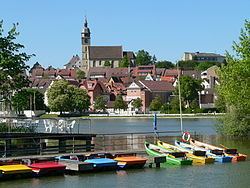Time zone CET/CEST (UTC+1/+2) Area 39.04 km² Population 46,380 (31 Dec 2008) Dialling code 07031 | District Böblingen Postal codes 71032, 71034 Local time Thursday 6:55 PM Team SV Böblingen | |
 | ||
Weather 6°C, Wind SW at 11 km/h, 59% Humidity | ||
Böblingen ( [ˈbøːblɪŋən]) is a town in Baden-Württemberg, Germany, seat of Böblingen District. Sindelfingen and Böblingen are contiguous.
Contents
- Map of BC3B6blingen Germany
- History
- Transport
- US military
- Education
- Museums
- Buildings
- Events
- Business
- Sports
- International relations
- Sons and daughters of the city
- References
Map of B%C3%B6blingen, Germany
History
Böblingen was founded by Count Wilhelm von Tübingen-Böblingen in 1253. Württemberg acquired the town in 1357, and on 12 May 1525 one of the bloodiest battles of the German Peasants' War took place in Böblingen. Jörg Truchsess von Waldburg attacked a force of 15,000 armed peasants; 3,000 were killed. By the end of the Thirty Years' War in 1648, the population of Böblingen had been reduced to 600.
After the establishment of the Kingdom of Württemberg, Böblingen became the seat of an Oberamt (administrative unit) in 1818. The town was connected to the railroad network in 1879, allowing industrialization to take place. In the context of administrative reform in 1938, Böblingen Oberamt became Böblingen Landkreis (district).
During the First World War an airbase was established. It went into service on 16 August 1915. It had a significant impact on the further development of the city. In 1925 the airbase became the Landesflughafen (state airport) of Baden-Württemberg called Böblingen Airport. The aircraft pioneer Hanns Klemm (1885–1961) established his company "Klemm Leichtflugzeugbau GmbH" ("Klemm Light Aircraft Company") next to it. Until the Second World War it was the major employer in Böblingen.
During the Second World War the town had a Luftwaffe airbase and military barracks. On 1 September 1939 (the day the war began) the airbase was the home station for the I/JG 52 (1st Group of the Jagdgeschwader 52) flying the Bf109 E-1 fighter aircraft.
On the night of 7 October 1943 during World War II, Allied air forces dropped 408 incendiary bombs and 35 high explosive bombs killing 20 men, 12 women, 12 children and wounding 200 people. 1,735 people lost their homes and 70 percent of the old town was destroyed. In July 1944 another attack followed, killing 36 more civilians.
In 1962, Böblingen was designated a Große Kreisstadt (major district town). Its current boundaries were established in 1971 when it was merged with the municipality of Dagersheim.
Transport
Böblingen is easily reached by multiple forms of transport.
Böblingen is about 20 minutes via S-Bahn from Stuttgart Airport.
The interchange between the federal freeways (Autobahn) A 8 and A 81 lies northeast from Böblingen. A 81 leads past the north of the city. Use exits Böblingen Ost (East), Böblingen/Sindelfingen, Böblingen Hulb and Ehningen. Federal highways B 464 (Renningen - Reutlingen) and B 14 run by the city.
Böblingen station lies on the Gäu Railway (Gäubahn) from Stuttgart to Singen. Regional trains serve the city every hour.
Local public transport within Böblingen operates under the uniform prices and coordination of the Verkehrs- und Tarifverbund Stuttgart ("Stuttgart Transit and Fare Association", or VVS). The S1 (Kirchheim unter Teck–Stuttgart–Herrenberg) S-Bahn (suburban rail) line connects Böblingen with Stuttgart and its S-Bahn network. Travel time to Stuttgart is about 25 minutes.
In 1996 the Schönbuchbahn line to Dettenhausen was re-activated. In 2004 the reactivation of the Rankbachbahn line to Renningen began and since 2010 it has been served by line S60 of the S-Bahn.
In addition to the main rail station, the following stations also serve the city: on S-Bahn line S1: Goldberg and Hulb; on the Schönbuchbahn line: Danziger Street, Böblingen Süd (South), Heusteig Street, and Zimmerschlag. Numerous bus routes operate in the city, and are also under the VVS.
U.S. military
Panzer Kaserne (translated as Tank Barracks) is a US base which serves as headquarters for Marine Corps Forces, Europe (MARFOREUR), 'Marine Corps Forces, Africa (MARFORAF) and the 1st Battalion of the US Army's 10th Special Forces Group (United States). This former German military installation was the home of the US Army's 7th Army Support Command (7th Army SUPCOM) until mid-1969 and its VII Corps successor VII Corps COSCOM (Corps Support Command). Later, units of the 3rd Brigade of the 1st Infantry Division (Forward) were stationed here as part of VII Corps.
Education
Education in Germany has two lower levels of school, Kindergarten and elementary school (Grundschule - grades 1–4), and three upper levels of school, Werkrealschule (grades 5–9/10), Realschule (5–10) and Gymnasium (5–12/13). Parents decide at the end of the fourth grade, which level of school the child should attend based on academic performance and aptitude.
In Boeblingen there are:
Museums
Buildings
Events
"Böblinger Jahrmarkt" in July, wine festival in September and Christmas Market in December).
Business
The Böblingen/Sindelfingen area is the location of several large enterprises:
Böblingen/Sindelfingen can be called a center of both automobile and computer industries. Daimler develops and manufactures its Mercedes brand of luxury cars here.
Hewlett-Packard (and its offsprings) and IBM develop computer systems, software and electronic products in the area. Böblingen was once also a major center of European computer manufacturing, with an IBM semiconductor and printed circuit board lab and an HP computer systems manufacturing operation. Most of those electronics-production sites have either been closed or moved to other locations (such as nearby Herrenberg).
Sports
The Sporthalle (Böblingen) served as one of two playgrounds for the FIBA EuroBasket 1971.
International relations
Böblingen is twinned with:
All twin cities compete in a twin town Olympiad every 3 years, excluding Sömmerda.
